Configurable Options in the Accounting Module
The Accounting module of the Odoo platform will provide the complete operational
management of the financial aspect of any company operations. As Odoo is a customizable
software the various aspects of financial management as well as accounting operations
can be customized. Furthermore, the Odoo platform is provided with a settings menu
in the Accounting module where various default options are available to be configured.
The settings menu is available in all the modules of Odoo providing the users with
the full freedom of configuring the operational management and function of each.
You will have configurable options that are available in the form of enabling and
disabling it using a selection box. There will also be options from which you can
choose the entity from the drop-down menu helping you to configure the operation.
All these forms of options are described based on the custom operational need. You
will also have the provision to bring in custom options while developing the platform
which can be done with the help of expert Odoo developers. Installing various third-party
Odoo apps available in the Odoo app store will bring configurable options to the
allocated modules helping you to define the operations. Additionally, using the
Studio module you will be able to customize the available default modules. You will
also be able to create custom modules using the Odoo studio module with configurable
options just as in all other default modules.
The accounting module has a long list of configurational options that are available
under the Settings tab for you to configure. These options will allow you to define
the operations of the accounting operations as well as finance management just as
you need. Moreover, these are default options that are available in both the community
as well as enterprise editions of Odoo. However, the functional options are limited
in the community edition and are way more advanced in the enterprise edition. Let's
now move on to understand the functionality of each option available in the Settings
tab of the Accounting module from the next sections.
Define the taxes based on the region
Configure your operational taxes for the functional aspects of your company under
the Taxes tab of the Settings module. The taxes defined here will be applicable
to both the sales and purchase operations if a specified tax is not set on the product
or else the taxes defined here will be taken into account for the operations. Let's
now look into the options in the Taxes configuration aspects in the Accounting module
settings menu.
Default Taxes
Initially, in the Taxes section, you will be able to configure the Default Taxes
for the operation of the business on the platform. These taxes are applied to all
the local transactions that are being defined in the platform. Here the Sales Tax
and the Purchase Tax can be selected from the drop-down menu available. The taxes
can be defined in the Taxes accessible from the Configuration menu of the Accounting
module, here you just allocate the respective taxes to be operational based on your
need. The following screenshots depict the Default Taxes configuration menu under
the Settings tab of the Accounting module.
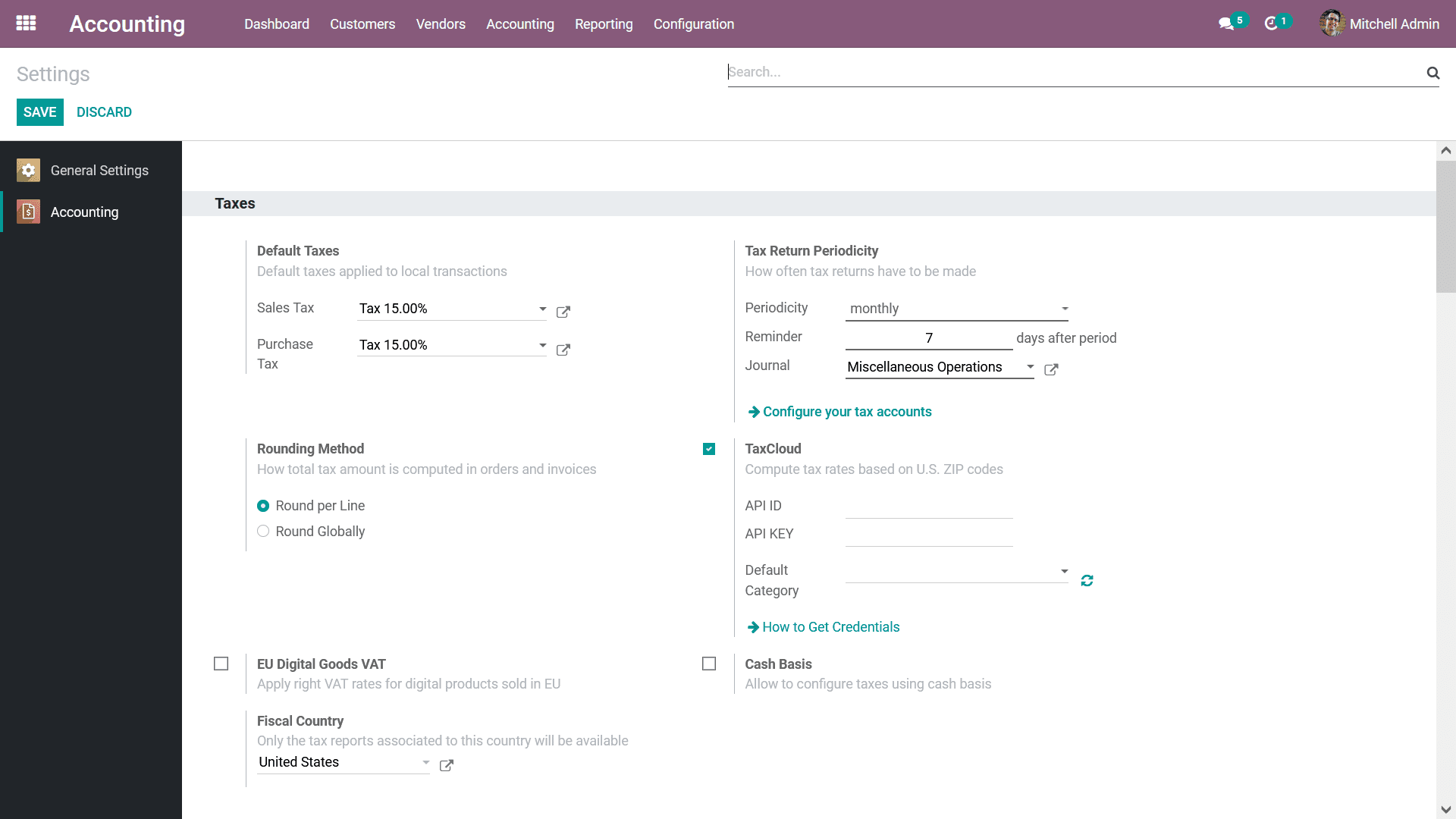
Tax Return Periodicity
The tax that is collected should be returned to the authorities during the specific
intervals, it can be based on the operational principle of the industries as well
as the authorities. The return filing interval will be based on the authorities
and it can be every month, quarterly, or half-yearly, or every year. You can configure
the return aspects under the Tax Return Periodicity menu which will imply how often
the tax returns have to be made.
Under the menu, you can configure the Periodicity which can be set as Annually,
Semi-annually, Every 4 months, Quarterly, Every 2 months, or Monthly. Furthermore,
you can also configure a Reminder which can be set for the days after the period.
Moreover, the Journal in which the taxes collected will be stored can be defined
in the menu, these will be the Journals that have been already defined in the platform
for the operations.
You can also configure the tax accounts by selecting the Configure Your Tax accounts
option available which will direct you to the Tax Groups window where the account
details of the Taxes can be defined. Here, the taxes defined will be depicted and
you can choose each of them to configure the Tax account. You can allocate the Tax
current account(payable), Tax current account (receivable), and the Advance Tax
payment account, in the Tax Groups menu just as depicted in the following image.

Rounding Method
Another aspect that can be configurable in the Taxes menu will be the Rounding aspects
of the taxes received, which can be based on two options that are available by default
in Odoo. It can be Round per line or Round Globally these two options can be chosen
based on your need for the operation.
Taxcloud
Considering a business operating in the US the TaxCloud computation will determine
the taxes on the sales, purchase as well all other company operations. The configuration
of the TaxCloud will be based on the US ZIP codes which is one of the localization
elements of the Odoo platform. The TaxCloud option can be enabled or disabled in
the Taxes configuration menu just as depicted in the image here, you will also be
able to describe the API ID, API Key as well as the Default Category which can be
custom-defined. There is also an option available to keno about the credential aspects,
you can choose the how to get credentials option which will take you to the TaxCloud
configuration webpage where you can abstain from the credentials or the account.
EU Digital Goods VAT
If the country in which your business functions while selling digital-based products
by your business you are liable to be following the EU Digital Goods VAT guidelines.
The Odoo considers this as a localization aspect and provides you with an option
to enable or disable the EU Digital Goods VAT based on the European Union. Additionally,
the Fiscal Country of operations can be selected from the drop-down menu, which
will provide the tax allocation concerning the selected country for your Odoo related
operations.
Cash Basis
The Taxes menu has a Cash Basis option allowing you to manage the operations of
taxes on the payments received through cash. This option can be enabled or disabled
based on the company policy.
Let's move on to understand the next operational menu under the settings which are
based on the currency management in the next section.
Having an excellent currency management system will do wonders
The Currencies menu available under the Settings tab of the Accounting module will
help you to define the currency-based operations of the company functioning with
Odoo. Here, in this menu, the Main Currency for the operation of the company can
be defined. The Currency can be chosen from the dropdown menu available in the option.
All the currencies of the world will be defined over here. Additionally, the main
currency of operations will be the currency in which the company is defined and
the additional currencies which are supported by your company operations can be
chosen.
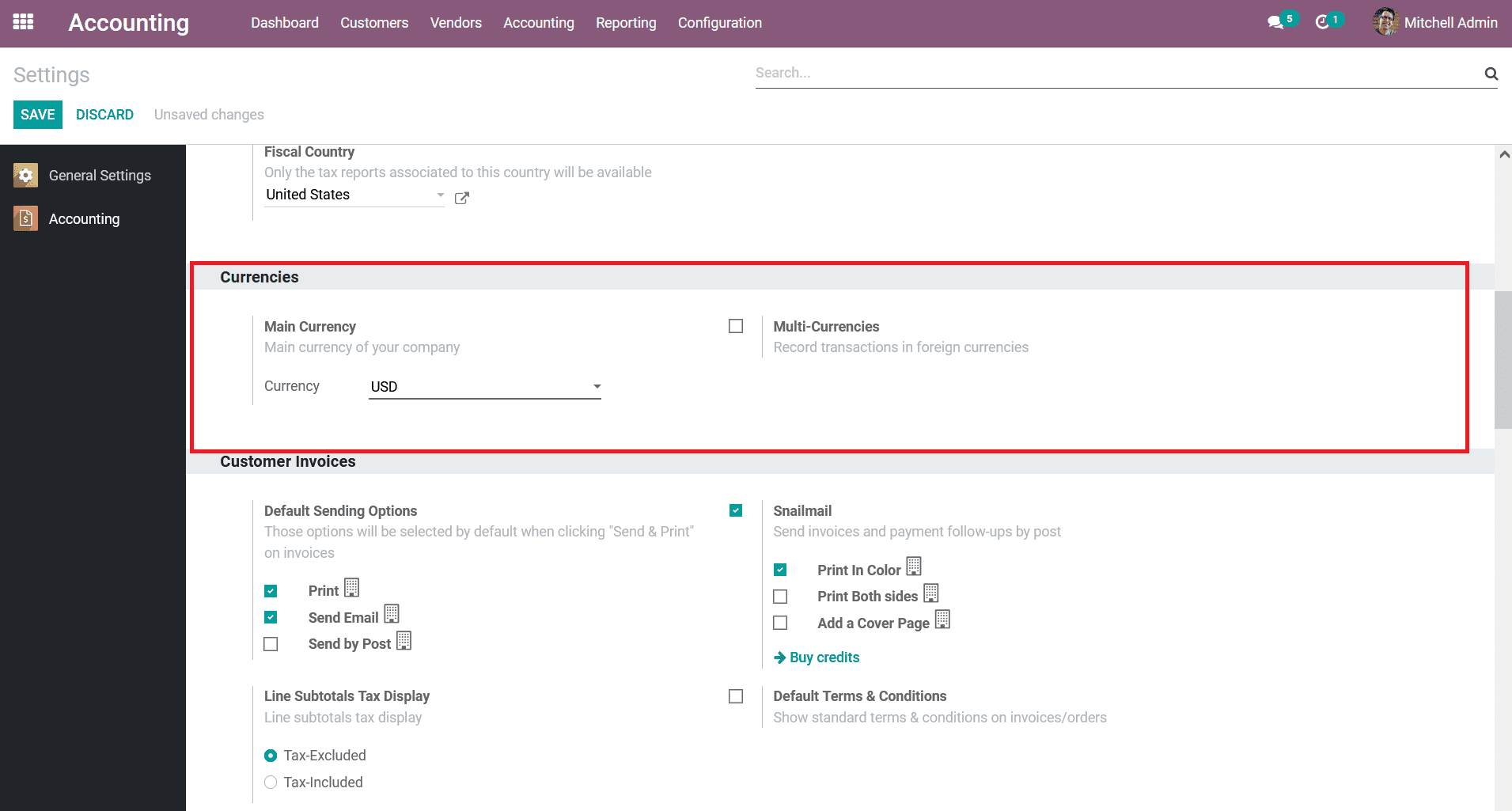
Moreover, if your country functions as an international label you need to run your
business in multiple countries and the currency management of each country should
be done effectively. Therefore, the Odoo platform has an option to configure the
Multi-Currency option helping you to record the traction in any currency of the
world. Let's now move onto the next menu available under the Settings tab of the
Accounting module, the Invoice management in the next section.
Complete and effective invoice management
Sending out the Customer Invoices along with the aspects of the management will
help you with the complete and effective operation of the invoice generation. Initially,
you need to configure the default settings option available in the Customer Invoices
section. The Default Settings Options on the invoice generation and Send & Print
can be configured. The sending options of the invoices can be configured as Print,
Sent Email, or Send by Post, if these options are configured, you can find them
depicted in the Send Invoice window just as depicted in the following image for
you to choose.
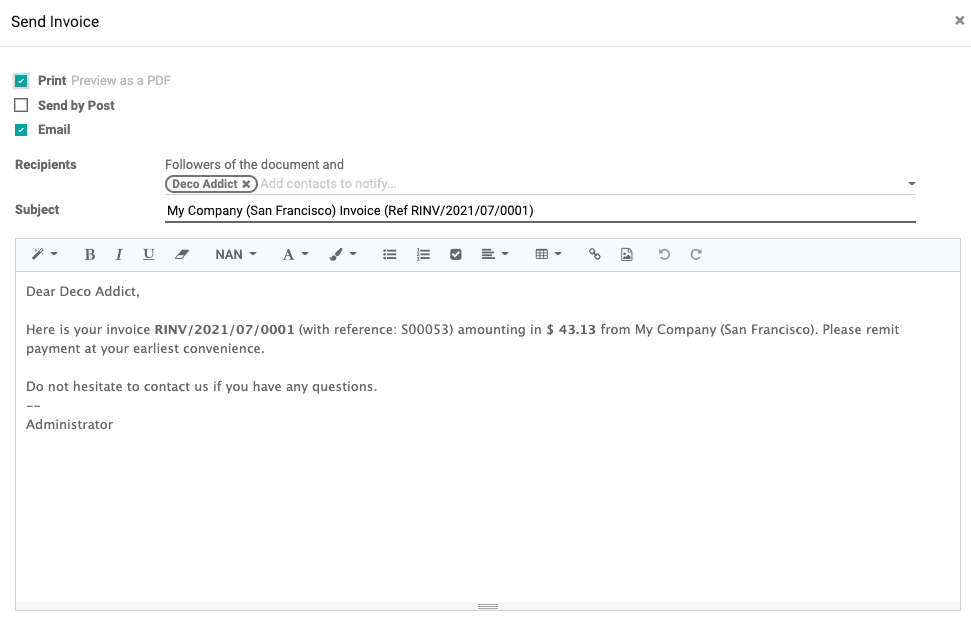
In addition, the Line Subtotal Tax Display on the invoices which are being generated
can be configured as either Tax-Excluded or Tax-Included based on the operational
demand of the business or as per the guidelines by the authorities.
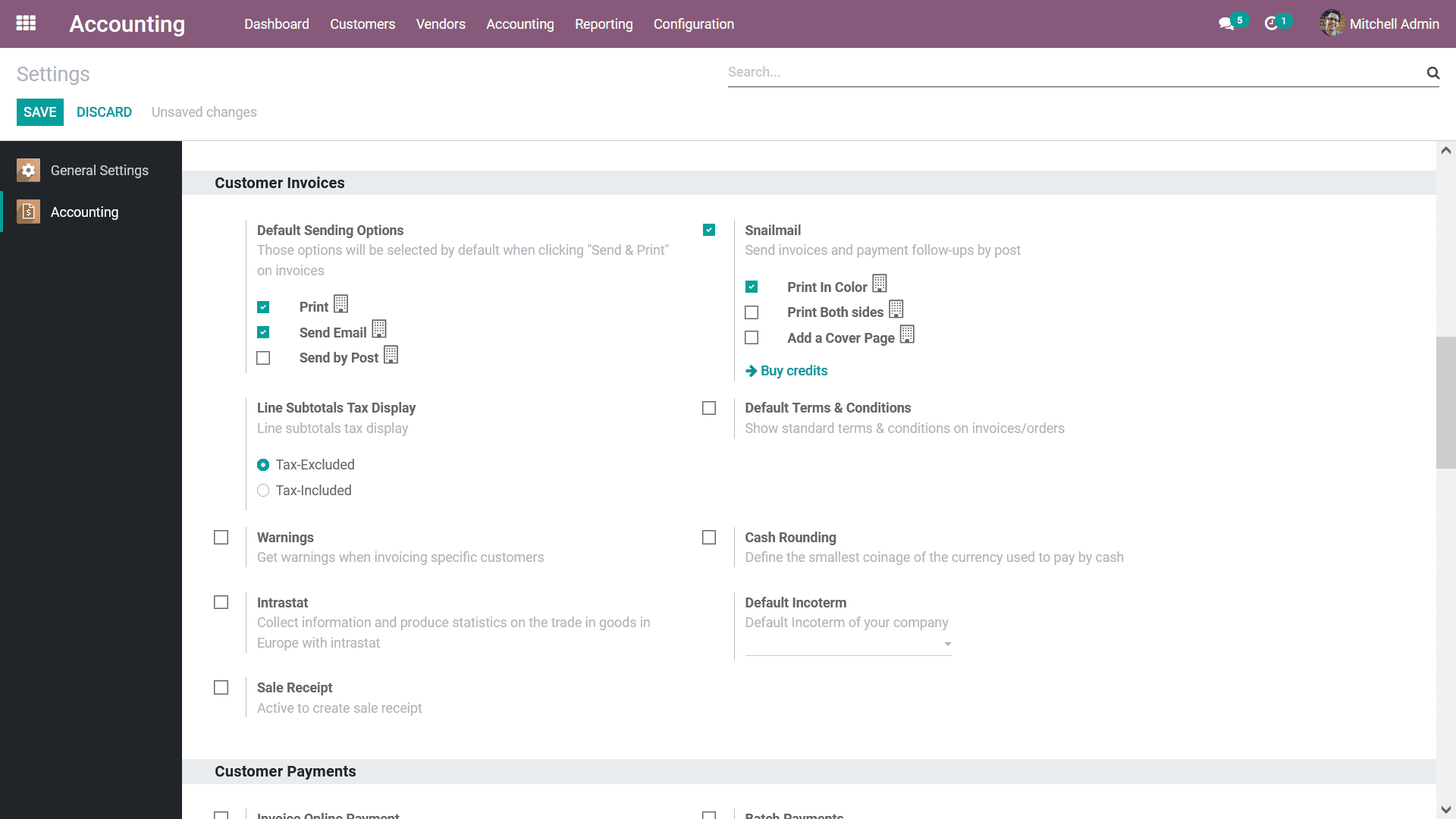
Snailmail is another localization feature available helping you to send out the
invoices by post directly. You can enable the Snailmail option available under the
Customer Invoices and configure the invoices directly to the customer. The Snailmail
can be configured with the default options such as the Print in Colour, Print both
sides, or Add a cover page. The operations of Snailmail are integrated based on
the expense of credits therefore, the platform also has a Buy Credit option available
in the Settings menu which will direct you to the webpage where you can buy Odoo
credit for Snailmail.
Additionally, you have various other options to be configured under the Customer
invoices by enabling or disabling the respective options such as the Default Terms
& Conditions which will be depicted in the invoice, Warnings, Cash rounding, Intrastat,
Default incoterm and Sales receipt. Let's understand these options in detail.
Warnings
Enabling the warning option available will help you to set warnings on respective
customers that have been defined in the Odoo platform. These warning messages will
be displayed to you once the invoices are being generated. Moreover, these warnings
can be custom-defined based on your need to inform the operators based on the customer.
Thus you will be able to block the sales and the invoice generation to the respective
customer.
Cash rounding
In the retail time operations of the business the chances of having the exact cash
in change as well the counter having coins to return the balances of the purchase
are low therefore, you will round the invoice prices to a whole number. With Odoo
you can define the Cash Rounding operation based on your custom requirement on the
currency with which you operate. You can enable the Cash rounding option available
here and then you will be depicted with a Cash rounding menu icon where the Cash
Roundings will be defined.
Intrastat
Another element of localization regarding the operations of the business in Europe
by Odoo is the configuration of Intrastat which can be done here by enabling the
option. Upon enabling the option, you will be depicted with the option to set the
Default incoterm which can be selected from the drop-down menu.
Default Incoterm
Along with the capability to set up the Default Incoterm, the Odoo Accounting module
settings have an option to set the Default incoterm by default. Moreover, there
is a drop-down menu available for you to choose the Default Incoterm.
Sales Receipt
Upon enabling the Sales Receipt option, a receipt on the sales of the product can
be generated after the sales are conducted. This will ensure that the same quantity
of products is sold, invoiced, and delivered.
There are all the aspects of configuration available under the invoice management
of the customers under the accounting module. Let's now move on to the next section
where the configuration options regarding the Customer Payments management are in
the next section.
Streamline the customer payments
Customer Payment management is of vital importance regarding the financial operations
of any company and the settings menu of the Odoo Accounting module will have various
configuration options regarding it. You can enable options such as Invoice Online
Payments to help the invoices of the customers to be paid online. Additionally,
the Batch Payment option can be enabled which will allow the customer to pay for
the invoices in a batch. The SEPA Direct Debit(SDD) is a localization tool helpful
for European countries helping you to collect payment from customers in one click
from the Euro SEPA services. The following image depicts the Customer Payments management
options available in the Settings menu of the Accounting module.
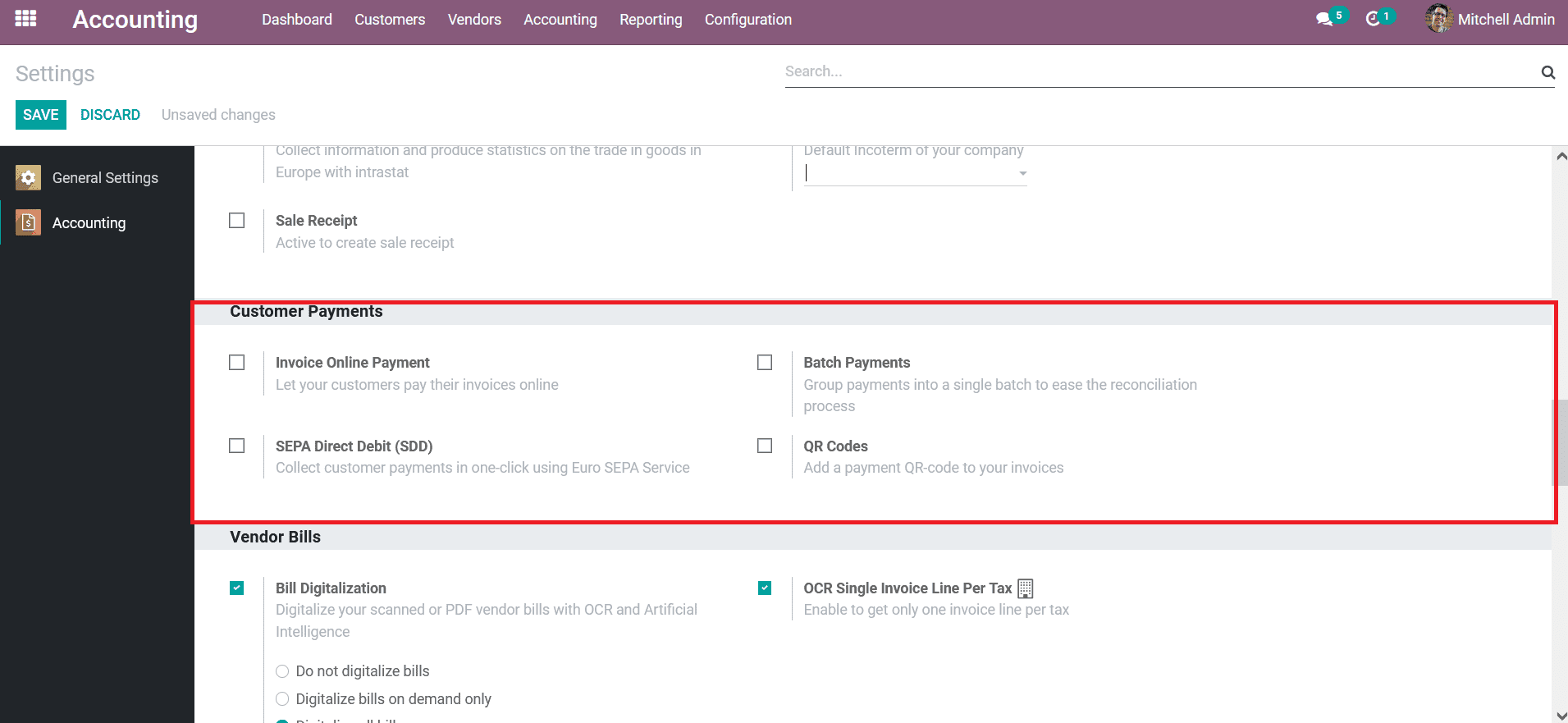
Enabling the QR Codes will help you to add a QR code to your invoices which the
customers can scan to generate the payments. With all these options you will be
able to define and function with the Customer Payment management effectively. Until
now we were discussing customer invoice generation and payment management. Let's
now move on to understanding the aspects of Vendor bill management in the next section.
Well defined vendor bills configuration tools
The vendor bills of the products which have been purchased can be easily managed
in Odoo with the Odoo accounting module. For the effective management of the Vendor
Bills, you need to configure the respective options in the settings menu of the
Accounting module. In the menu you will have options such as Bill Digitalization
which can be configured as Do not digitalize bills, Digitalize bills on-demand only,
or Digitalize all bills automatically. In case you need to digitize bills you need
to expense certain credits which can be brought by selecting the Buy Credit options
available. Furthermore, you can enable the OCR Single Invoice Line Per Tax option
helping you to get only one Invoice Line per tax. In addition, the Purchase Receipt
option can be enabled to create the purchase receipts to be product procurement
operations.
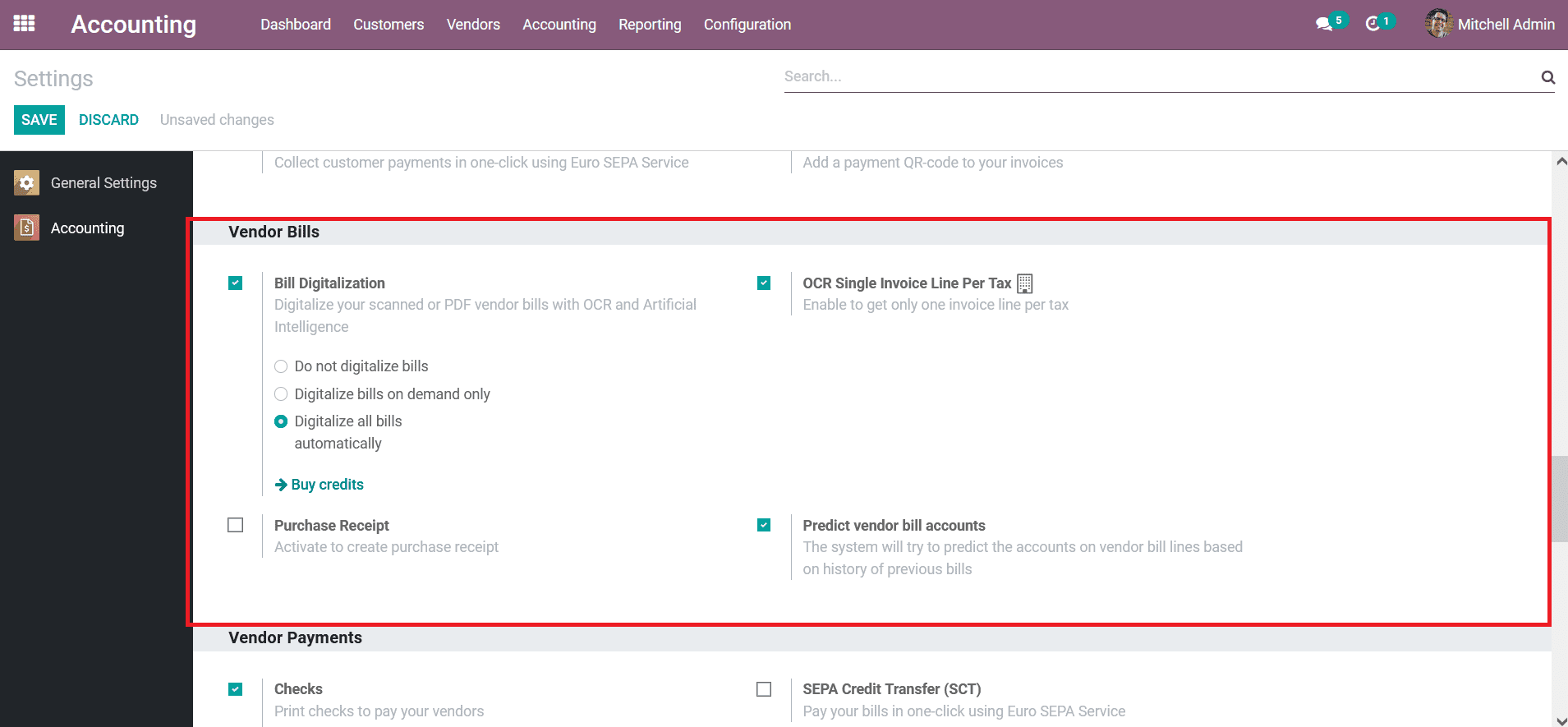
The Predict vendor bill accounts is an advanced option of the Accounting module
of the Odoo platform helping you with providing a predictive insight on vendor bills
based on the previous bills from the vendors. These are the various options available
under the Vendor Bills which you can configure. Let's now move on to the aspects
of Vendor Payments management options available in the settings menu.
Full control on vendor bill payment
The Odoo Accounting module has advanced options to manage the operations of the
Vendor Payments which will be helpful for the accounting management options of the
company. You can configure the Checks option by enabling it and defining the Check
Layout by selecting it from the dropdown menu. Furthermore, you can enable the Multi-Pages
Check Stub and configure the Check Top Margin as well as the Check Left Margin.
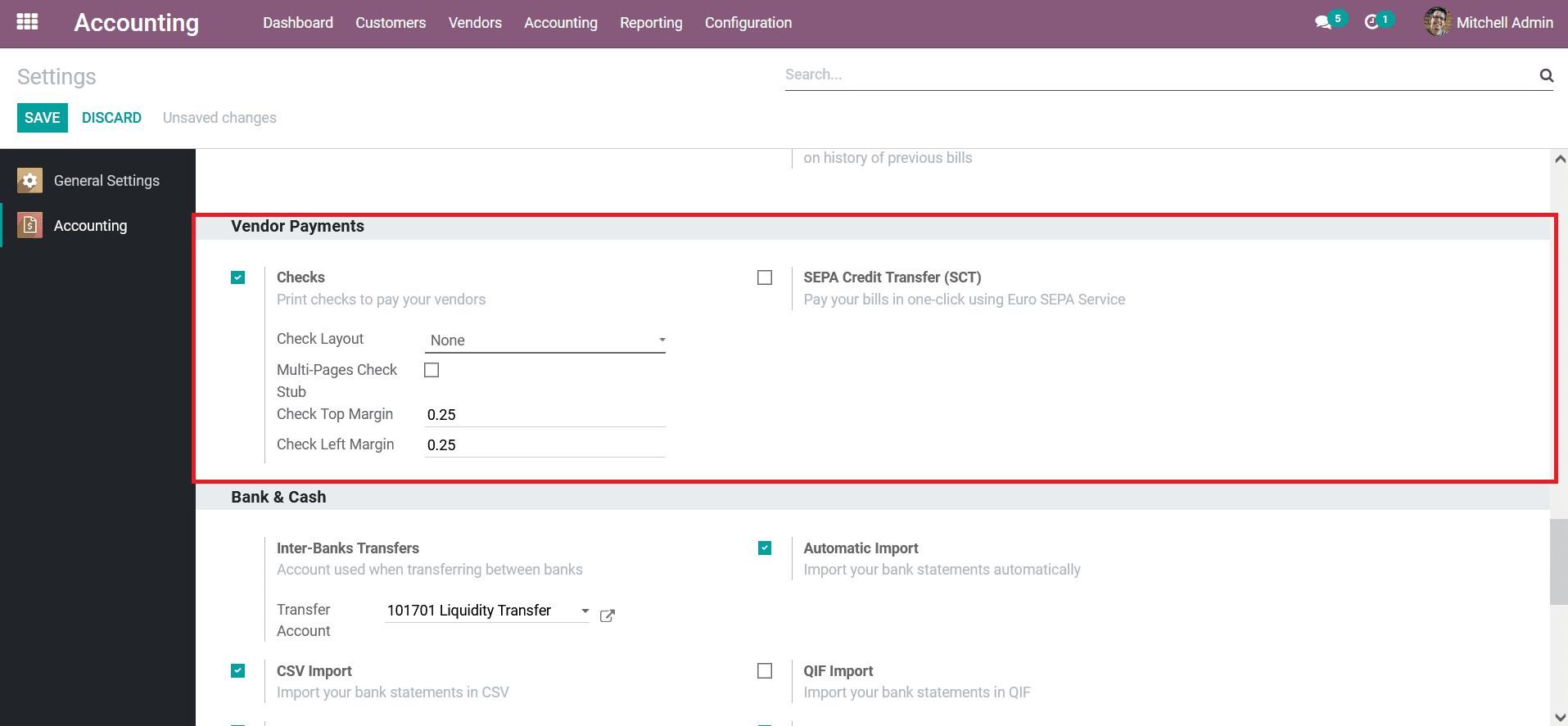
Additionally, the SEPA Credit Transfer(SCT) option is also available for business
in European countries allowing you to pay the bills in a click using the Euro SEPA
services. Let's now move on to understand the options available in the Odoo Accounting
Module Settings menu regarding the Bank & Cash management in the next section.
Managing the finances with bank and cash management
The Bank and Cash management options available in the settings menu of the Accounting
module will provide you with a complete insight into the effectiveness of operations.
You can configure the Inter- Banks Transfers under the menu by describing the Transfer
Account and functioning with it. Furthermore, the Automatic Import option can be
enabled which will allow you to import the bank statements automatically. Additionally,
you can enable the CVS Import option to import the bank statements in the CSV file.
The same can be done by enabling the QIF Import to import the bank statements in
QIF format.
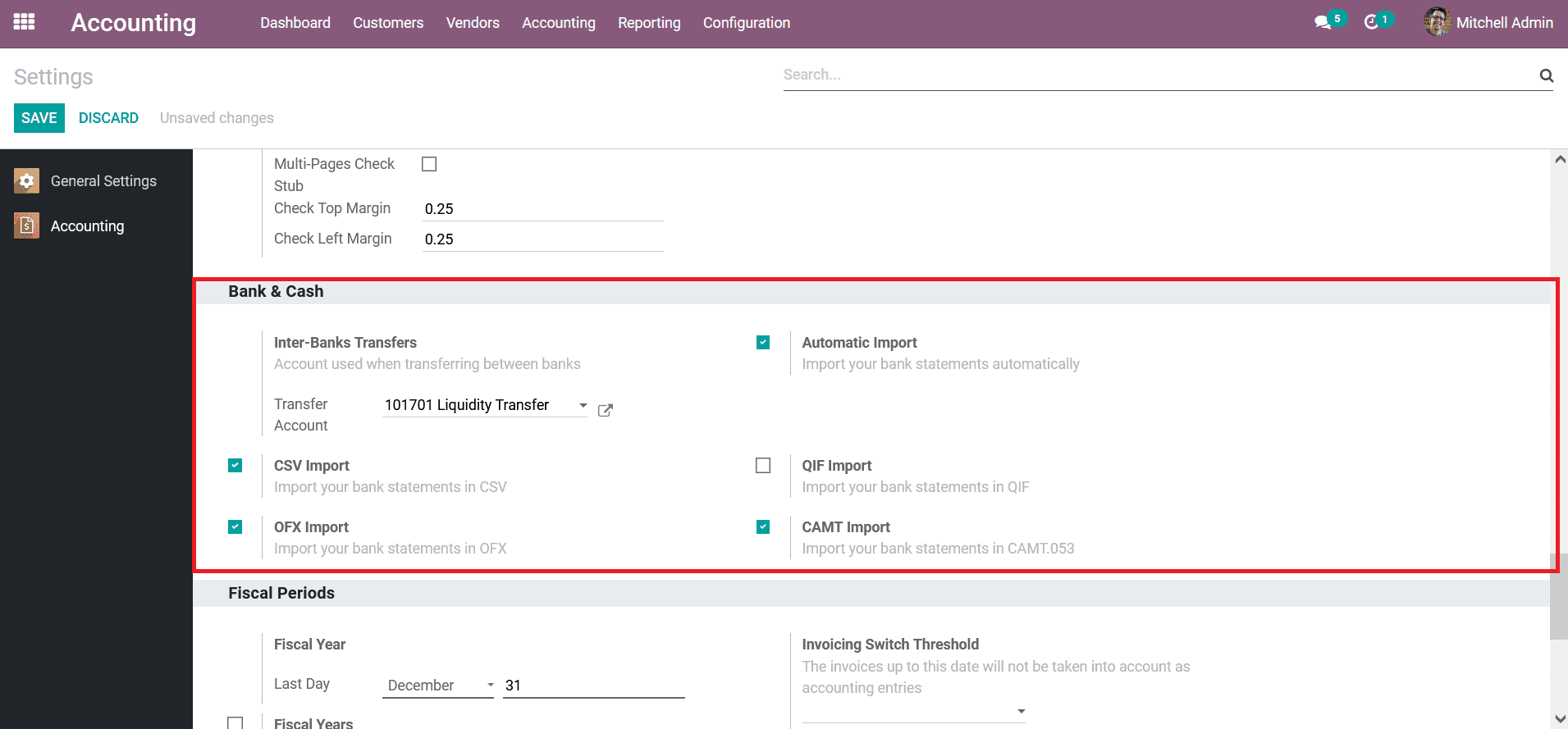
In addition, you will also have the QFX Import as well as the CAMT Import option
which can be enabled to import the bank statements in respective formats. Let's
now move on to understand the Fiscal Periods configuration aspects of the Odoo Accounting
module in the next section.
Configurable fiscal periods and positions
You will be able to define the Fiscal period of operations of your company in Odoo
under the Accounting module. Under the Fiscal period tab, you can configure the
Fiscal Year by defining the Last day along with the month. If the Fiscal operations
are to be conducted based on Fiscal Years you enable the option. Furthermore, you
can set a threshold for the invoices by describing the Invoicing Switch Threshold
by selecting the date from the calendar. The Invoicing Threshold can be configured
as any date which will ensure that all the entries before the respective date will
be set to the canceled state. Moreover, the reporting aspect, as well as the revenue
involved, will also be nullified and you will start to operate the business with
Odoo as a fresh start from the respective date set as the threshold.
The setting up of threshold is a useful feature during the development of Odoo as
it will allow you to remove all the test data in the aspects of invoices, vendor
bills, and the revenue involved in them. This means once the threshold is set after
all the test operations are complete the platform will reset to a new form ensuring
that all the test operations remain canceled. Let's now move on to understanding
the Analytical Accounting and Budget Management aspects of the Accounting module
in the next section.
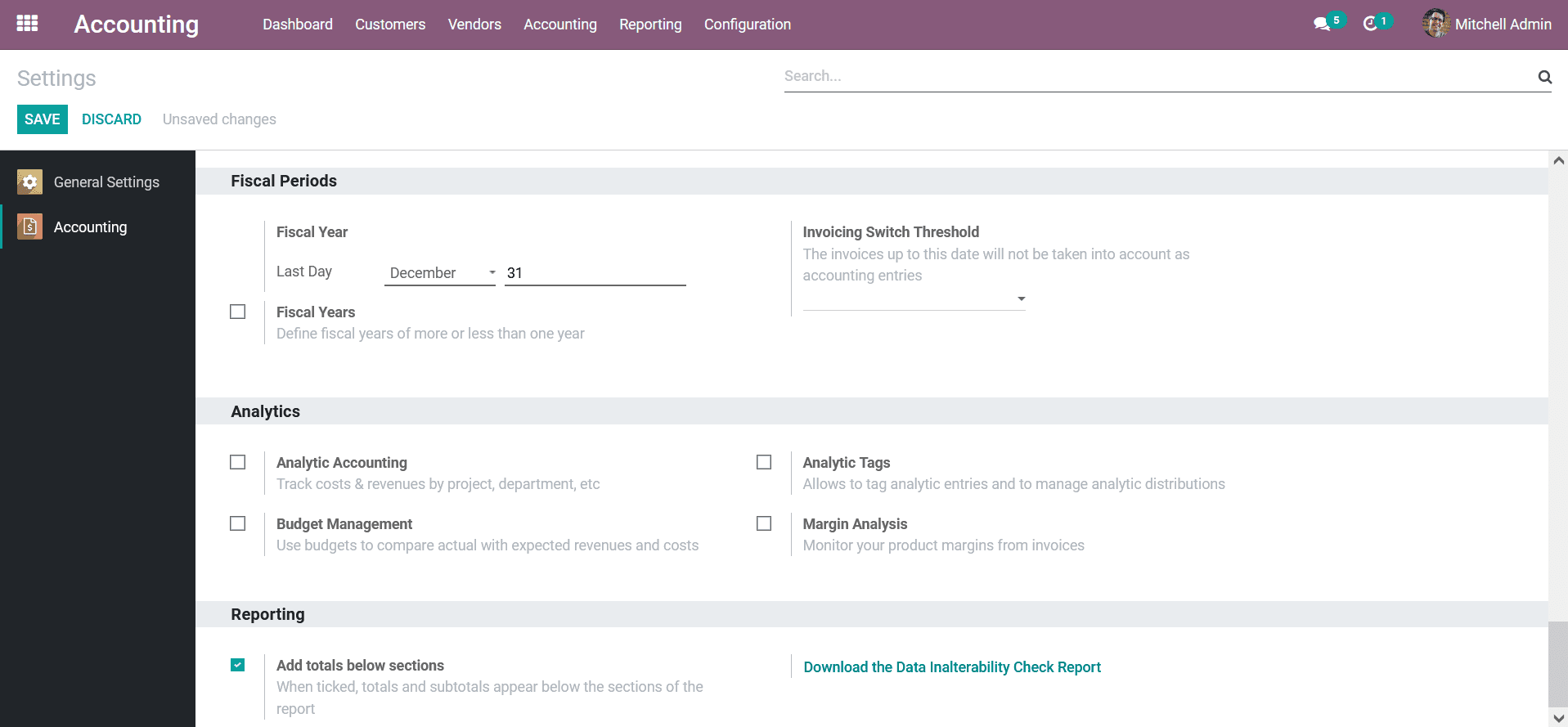
Analytical accounting and budget management
The Odoo Accounting module supports the aspects of Analytical Accounting helping
you to move a step ahead in the financial management operations of your company.
All the configurational aspects regarding Analytical Accounting can be configured
under the Analytic menu of the Settings tab of the analytical module. You can enable
and disable the aspect of Analytical Accounting for your business operations using
the option in the menu. Furthermore, the Analytical Tags can be enabled as per the
need of the operations to simplify the classification aspects of Analytical accounts
and their operations.
In addition, the Budget management options will ensure that you are provided with
effective management of the operations regarding the financial budget as well as
the assets that you have at the company's disposal. Moreover, enabling the Margin
Analysis option will allow you to monitor the product margins from invoices. The
options available under the Analytical Accounting configuration are depicted in
the settings menu of the Accounting module. Let's now move on to understand the
aspects of the configuration of report creation under the analytical reports.
Create informative reports
You will be having two options under the aspects of the configuration of the Report
generation under Analytical Accounting. Initially, you will have an option that
can be enabled to Add Totals below the sections which will describe the total amount
of the aspects of the report at the bottom. In addition, you will also be able to
Download the Data Inalterability Check Report from this menu by selecting the option
and the report will be downloaded to your system.
There are various configurable options available in the settings menu of the Accounting
module of the Odoo platform which can be described based on the operational need.
You can easily configure them to obtain the required functional operational control
of the financial aspects of your business.
In concussion in this chapter initially, we were discussing the basics of Odoo and
its configuration aspects of installations as well as hosting. Then we move on to
understanding the localization aspect of the platform and further to the configuration
aspects of the Odoo Accounting module. All the options in the settings menu of the
Accounting module were discussed in detail in this chapter.
In the next chapter, we will be focusing on the configuration tools that are available
in the accounting module in detail.